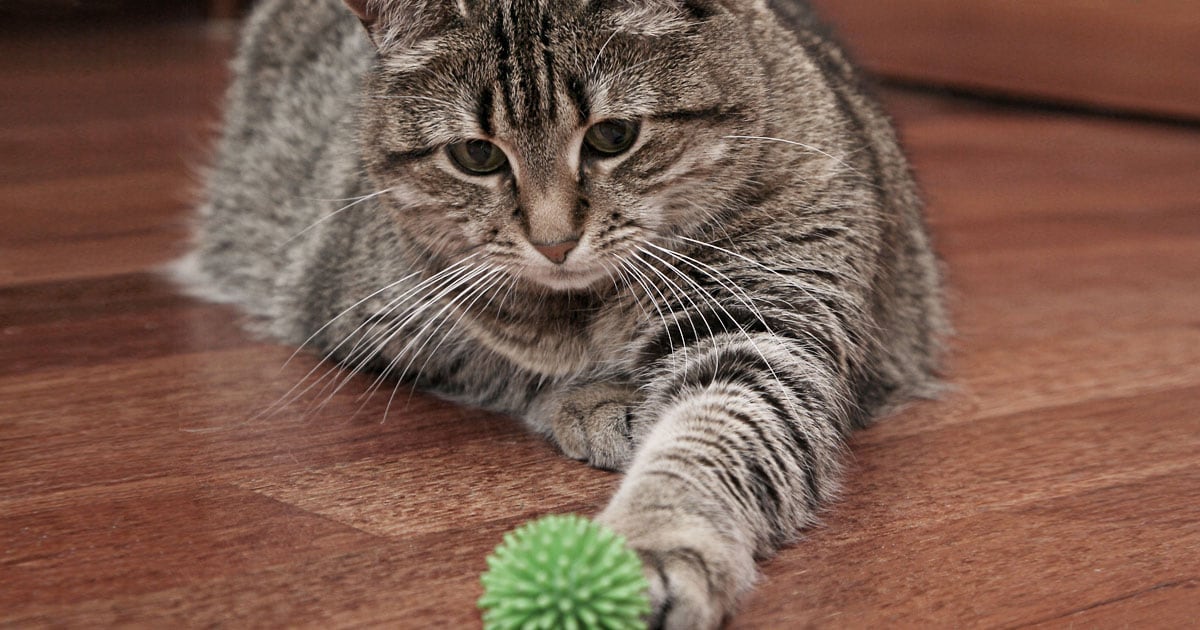Increasing an overweight cat’s activity is one part of an effective weight-loss program. Easy enough to say, but knowing what that means is another matter. Even veterinary experts are unsure how much exercise a cat really needs. And nothing — zero, zip, zilch, nada — is known about how many calories a cat burns during various activities, whether they are jumping after a feather toy or chasing a laser light.
The good news for busy cat parents is that increasing a cat’s activity level may not require a large time commitment. According to Angela Witzel, DVM, a board-certified veterinary nutritionist and chief of the clinical nutrition service at the University of Tennessee, increasing play or exercise for just 10 minutes a day can be highly effective in promoting weight loss in overweight cats.
Playtime: Consider the cat’s natural behavior
Because of their ancestry and evolution, cats are normally active in short bursts. They stalk and sprint to capture their prey. So it would make sense that their playtime — at least initially — could be done as short bursts for two to three minutes a couple of times per day. Some of these sessions can be scheduled in the morning and some in the evening, when your cat is naturally active.
Even if your cat seems uninterested at first or doesn’t have the stamina to play for long, be persistent. Some creativity may be needed to get your kitty moving. The good news is that as they lose weight, they will become more active and interested. And as their stamina improves, you can lengthen playtime or add additional sessions to your daily schedule.
In addition to burning calories, physical activity can decrease your cat’s appetite, help maintain muscle and provide mental stimulation — something a lot of indoor cats can benefit from. To help you get your kitty moving, here are some tips and tricks to consider.
Make your cat work for their food
One option to encourage your cat to move is to place their food in different rooms around your home. This is particularly helpful for very overweight or obese cats, who may have difficulty playing otherwise. Divide your cat’s daily amount of food into multiple (four to six) shallow bowls and hide them in different places: upstairs, downstairs, in your closet, on a windowsill. Or if your cat is only slightly overweight, put a food portion at the top of their cat tree so that they have to climb for it.
Another option that makes your cat work for their food is a food puzzle, which is a toy that can be filled with food. (Just remember to stay within your cat’s daily food allowance!) Food puzzles require your cat to “work” the toy to get the food to fall out. So not only does your cat move while eating, they are also being mentally stimulated. It’s a win-win-win!
Provide plenty of toys
Would it surprise you to learn each cat has a unique toy preference, based on their prey preference? In fact, cat play is almost entirely about tapping into your cat’s hunting behavior. You can learn your cat’s preference by watching their reaction to toys with specific qualities, such as feathers, “fur,” crinkling or squeaking noises, and types of movement. You may need to experiment to find the types of toys your cat prefers. Keep in mind that your cat will likely enjoy variety and may need several different types of toys to avoid boredom. To keep kitty interested, you’ll want to alternate toys and introduce new ones.
Toys for solo play, such as toys that cats can throw around themselves (a mouse with or without catnip) or bat around and chase (colored ball or mylar crinkle ball), are especially good for cats who spend much of the day alone. Toys that make a little noise can act as an extra stimulus — and are the ones you’ll want to hide if you want a good night’s sleep!
You most likely won’t be able to count on your kitty to increase their activity on their own — you’ll need to participate, too. Interactive toys, such as a remote-controlled mouse, laser pointer and feathers or mouse attached to the end of a string, can be fun for both you and your cat, as well as getting your cat to move. To stimulate your cat’s hunting behavior, be sure to move the toy so that it mimics the movements of a bird or mouse.
If you want to track your kitty’s progress, keep a journal of their activity. It can be as simple as noting the number of minutes played on a calendar or as detailed as the type of activity, number of play sessions and length of each one. You could also track your cat’s activity as part of a food and treat journal to record their weight-loss journey.
What types of toys does your cat enjoy playing with? Head over to our Facebook page to share the answer — photos or videos, too — with us!








